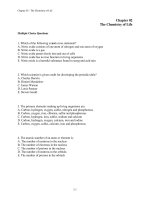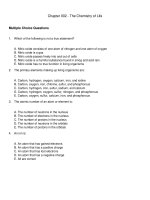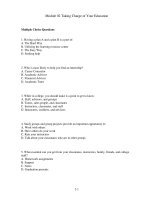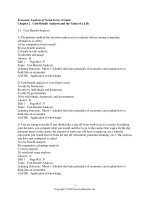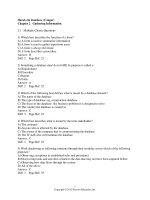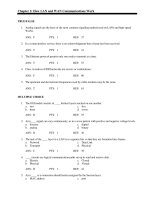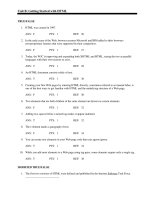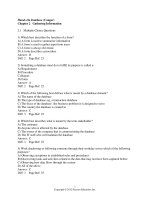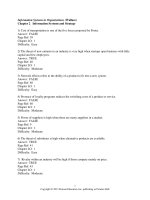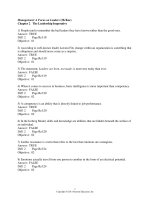Biology 1st edition marielle hoefnagels test bank
Bạn đang xem bản rút gọn của tài liệu. Xem và tải ngay bản đầy đủ của tài liệu tại đây (206.92 KB, 12 trang )
Chapter 02 - The Chemistry of Life
Chapter 02
The Chemistry of Life
Multiple Choice Questions
1. Which of the following is not a true statement?
A. Nitric oxide consists of one atom of nitrogen and one atom of oxygen
B. Nitric oxide is a gas
C. Nitric oxide passes freely into and out of cells
D. Nitric oxide has no true function in living organisms
E. Nitric oxide is a harmful substance found in smog and acid rain
2. Which scientist is given credit for developing the periodic table?
A. Charles Darwin
B. Dimitri Mendeleev
C. James Watson
D. Louis Pasteur
E. Steven Gould
3. The primary elements making up living organisms are:
A. Carbon, hydrogen, oxygen, sulfur, nitrogen and phosphorous
B. Carbon, oxygen, iron, chlorine, sulfur and phosphorous
C. Carbon, hydrogen, iron, sulfur, sodium and calcium
D. Carbon, hydrogen, oxygen, calcium, iron and iodine
E. Carbon, oxygen, sulfur, calcium, iron and phosphorous
4. The atomic number of an atom or element is:
A. The number of neutrons in the nucleus
B. The number of electrons in the nucleus
C. The number of protons in the nucleus
D. The number of neutrons in the orbitals
E. The number of protons in the orbitals
2-1
Chapter 02 - The Chemistry of Life
5. An ion is:
A. An atom that has gained electrons
B. An atom that has a positive charge
C. An atom that has lost electrons
D. An atom that has a negative charge
E. All of the above are correct
6. The mass number of an atom is defined as:
A. The total number of protons, neutrons and electrons of an atom
B. The total number of protons and electrons of an atom
C. The total number of protons and neutrons of an atom
D. The total number of neutrons and electrons of an atom
E. The total number of protons of an atom
7. Uses of radioactive isotopes include:
A. Tracers
B. Radiometric dating
C. The killing of disease causing organisms
D. Cancer therapy
E. All of the above are correct
8. Isotopes of the same element are different from one another in that:
A. They have a different number of neutrons
B. They have a different number of protons
C. They have a different number of electrons
D. They have a different mass number
E. Both A and D are correct
9. The maximum number of electrons in an orbital is:
A. One
B. Two
C. Four
D. Eight
E. Sixteen
2-2
Chapter 02 - The Chemistry of Life
10. If an atom has a valence shell that is full it:
A. Is chemically stable
B. Is highly reactive
C. Is not chemically stable
D. Is highly likely to combine with other atoms
E. Is not inert
11. The second energy shell of an atom contains a maximum of:
A. One electron
B. Two electrons
C. Four electrons
D. Eight electrons
E. Sixteen electrons
12. A covalent bond is a bond:
A. Formed by atoms of opposite charge attracting one another
B. Formed by atoms that share electrons
C. That is a strong bond
D. Both B and C are correct
E. Both A and C are correct
13. An ionic bond is a bond:
A. Formed by atoms of opposite charge attracting one another
B. Formed by atoms that share electrons
C. Is a bond pulled apart by water molecules
D. Both B and C are correct
E. Both A and C are correct
2-3
Chapter 02 - The Chemistry of Life
14. In the example of ionic bond formation between sodium and chlorine, which of the following
is not a true statement?
A. Na is the chemical symbol for sodium
B. Sodium donates an electron
C. Chlorine donates an electron
D. Sodium becomes positively charged
E. The bond that is formed is a strong bond
15. In the example of ionic bond formation between sodium and chlorine:
A. Na is the chemical symbol for chlorine
B. Chlorine accepts an electron
C. Sodium accepts an electron
D. Chlorine becomes positively charged
E. Both C and D are correct
16. If a covalent bond is polar:
A. Electrons are not shared by atoms
B. Protons are shared by atoms
C. One of the atoms has a partial negative charge
D. The bond is not important to living cells
E. The bond is not a strong bond
17. A hydrogen bond:
A. Is a strong bond
B. May occur between molecules
C. Does not occur within a molecule
D. Is not important to living cells
E. Usually has a hydrogen atom with a partial negative charge
2-4
Chapter 02 - The Chemistry of Life
18. Water:
A. Is cohesive
B. Dissolves polar substances
C. Regulates temperature
D. Participates in life's chemical reactions
E. All of the above are correct
19. Evaporation is:
A. The conversion of a liquid into a vapor
B. The conversion of a solid into a vapor
C. The conversion of a vapor into a liquid
D. The conversion of a vapor into a solid
E. None of the above are correct
20. Ice floats on water because:
A. The molecules are closer together in ice than in water
B. The molecules are farther apart in ice than in water
C. Ice is more dense than water
D. Both A and C are correct
E. Both B and C are correct
21. In a chemical equation:
A. The reactants are on the right of the yields arrow
B. Reactants and products are on both sides of the yields arrow
C. The products are on the left of the yields arrow
D. The reactants are on the left of the yields arrow
E. The number of atoms of each element may be different on the two sides of the yields arrow
2-5
Chapter 02 - The Chemistry of Life
22. An acid:
A. Is a chemical that takes hydrogen ions from a solution
B. Has a value of seven on the pH scale
C. Is a chemical that adds hydrogen ions to a solution
D. Has a value above seven on the pH scale
E. Both C and D are correct
23. A base:
A. Is a chemical that absorbs hydrogen ions from a solution
B. Has a value of seven on the pH scale
C. Is a chemical that adds hydrogen ions to a solution
D. Is a chemical that adds hydroxyl ions to a solution
E. Both A and D are correct
24. A substance having a pH of 2 would best be described as:
A. Neutral
B. A weak acid
C. A weak base
D. A strong acid
E. A strong base
25. A substance having a pH of 6 would best be described as:
A. Neutral
B. A weak acid
C. A weak base
D. A strong acid
E. A strong base
26. A substance having a pH of 7 would best be described as:
A. Neutral
B. A weak acid
C. A weak base
D. A strong acid
E. A strong base
2-6
Chapter 02 - The Chemistry of Life
27. A substance having a pH of 8 would best be described as:
A. Neutral
B. A weak acid
C. A weak base
D. A strong acid
E. A strong base
28. A substance having a pH of 13 would best be described as:
A. Neutral
B. A weak acid
C. A weak base
D. A strong acid
E. A strong base
29. Organic molecules are defined as chemical compounds that contain:
A. Carbon
B. Carbon and oxygen
C. Carbon and nitrogen
D. Carbon and hydrogen
E. Carbon, hydrogen and nitrogen
30. The four major groups of organic compounds are:
A. Fats, waxes, carbohydrates and amino acids
B. Carbohydrates, lipids, proteins and nucleic acids
C. Carbohydrates, lipids, steroids and monosaccharides
D. Lipids, fats, waxes and steroids
E. Carbohydrates, proteins, amino acids and nucleic acids
31. A process by which cells build large molecules from monomers is:
A. Dehydration synthesis
B. Hydrolysis
C. Condensation
D. Reproduction
E. Both A and C are correct
2-7
Chapter 02 - The Chemistry of Life
32. A process by which cells break polymers down into smaller units is:
A. Dehydration synthesis
B. Hydrolysis
C. Condensation
D. Reproduction
E. Both A and C are correct
33. Examples of monosaccharides are:
A. Glucose, galactose and fructose
B. Glucose, maltose and cellulose
C. Glucose, lactose and maltose
D. Glucose, lactose and cellulose
E. None of the above are correct
34. Which is not a lipid?
A. A triglyceride
B. A phospholipid
C. A starch molecule
D. A wax
E. A sterol
35. The primary building block (monomer) of proteins is:
A. A glucose molecule
B. A fatty acid
C. A nucleotide
D. An amino acid
E. Four interconnected rings
36. An amino acid contains:
A. Four interconnected rings
B. A central carbon atom
C. An R group
D. Both A and C are correct
E. Both B and C are correct
2-8
Chapter 02 - The Chemistry of Life
37. A peptide bond:
A. Is a covalent bond
B. Is an ionic bond
C. Is a strong bong
D. Both A and C are correct
E. Both B and C are correct
38. The primary building block (monomer) of nucleic acids is:
A. A glucose molecule
B. A fatty acid
C. A nucleotide
D. An amino acid
E. Four interconnected rings
39. The three major components in a nucleotide are:
A. Glucose, a fatty acid and glycerol
B. A nitrogen base, a five carbon sugar and a phosphate group
C. A nitrogen base, a six carbon sugar and a phosphate group
D. Glucose, a nitrogen base and a phosphate group
E. A carboxyl group, an R group and an amino group
40. The four nitrogen bases found in RNA are:
A. Adenine, thymine, guanine and uracil
B. Adenine, thymine, cytosine and uracil
C. Thymine, cytosine, guanine and uracil
D. Adenine, cytosine, guanine and uracil
E. None of the above are correct
True / False Questions
41. The drug nitroglycerine relieves angina by helping to increase the internal diameter of blood
vessels that supply oxygen rich blood to the heart.
True False
2-9
Chapter 02 - The Chemistry of Life
42. A peptide bond is a covalent bond formed between the amino group of one amino acid and the
R group of another amino acid.
True False
43. Cohesion is a property of water in which water molecules tend to stick together.
True False
44. A substance in which other substances dissolve is called a solute.
True False
45. If ice were more dense than water, then during the winter most organisms living in ponds and
lakes in colder climates would become entrapped in ice and freeze.
True False
46. A fatty acid is unsaturated if there is at least one double bond between the carbon atoms in that
fatty acid.
True False
47. An essential amino acid is an amino acid that is found in all types of foods.
True False
48. The primary function of hemoglobin is to regulate the level of sugar in the blood.
True False
49. If a protein is denatured, its structure has been changed enough to make the protein
nonfunctional.
True False
2-10
Chapter 02 - The Chemistry of Life
50. Proteins store the genetic information of the cell and transmit it to the next generation.
True False
Chapter 02 The Chemistry of Life Key
1. D
2. B
3. A
4. C
5. E
6. C
7. E
8. E
9. B
10. A
11. D
12. D
13. E
14. C
15. B
16. C
17. B
18. E
19. A
20. B
21. D
22. C
2-11
Chapter 02 - The Chemistry of Life
23. E
24. D
25. B
26. A
27. C
28. E
29. D
30. B
31. E
32. B
33. A
34. C
35. D
36. E
37. D
38. C
39. B
40. D
41. TRUE
42. FALSE
43. TRUE
44. FALSE
45. TRUE
46. TRUE
47. FALSE
48. FALSE
49. TRUE
50. FALSE
2-12
